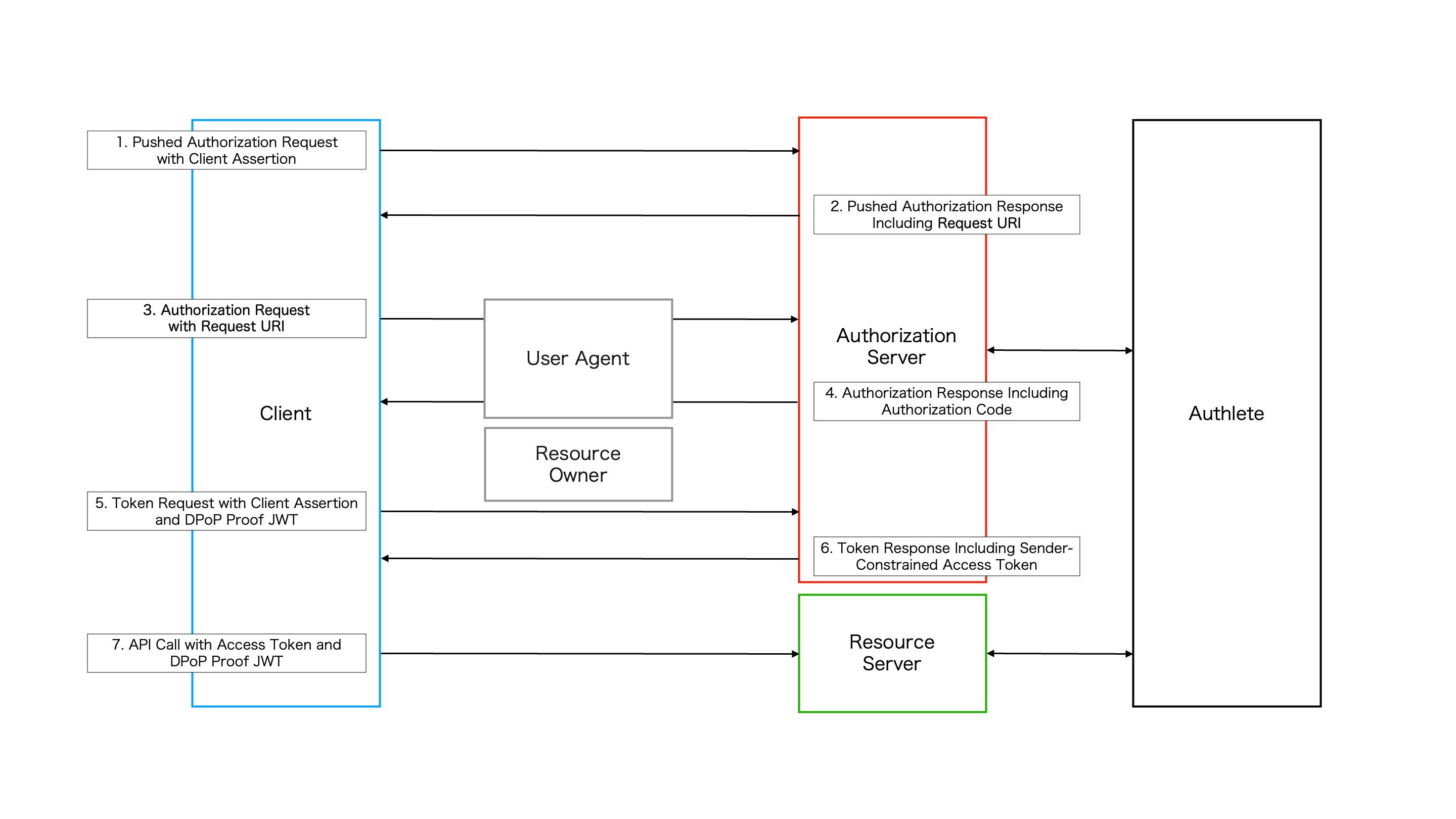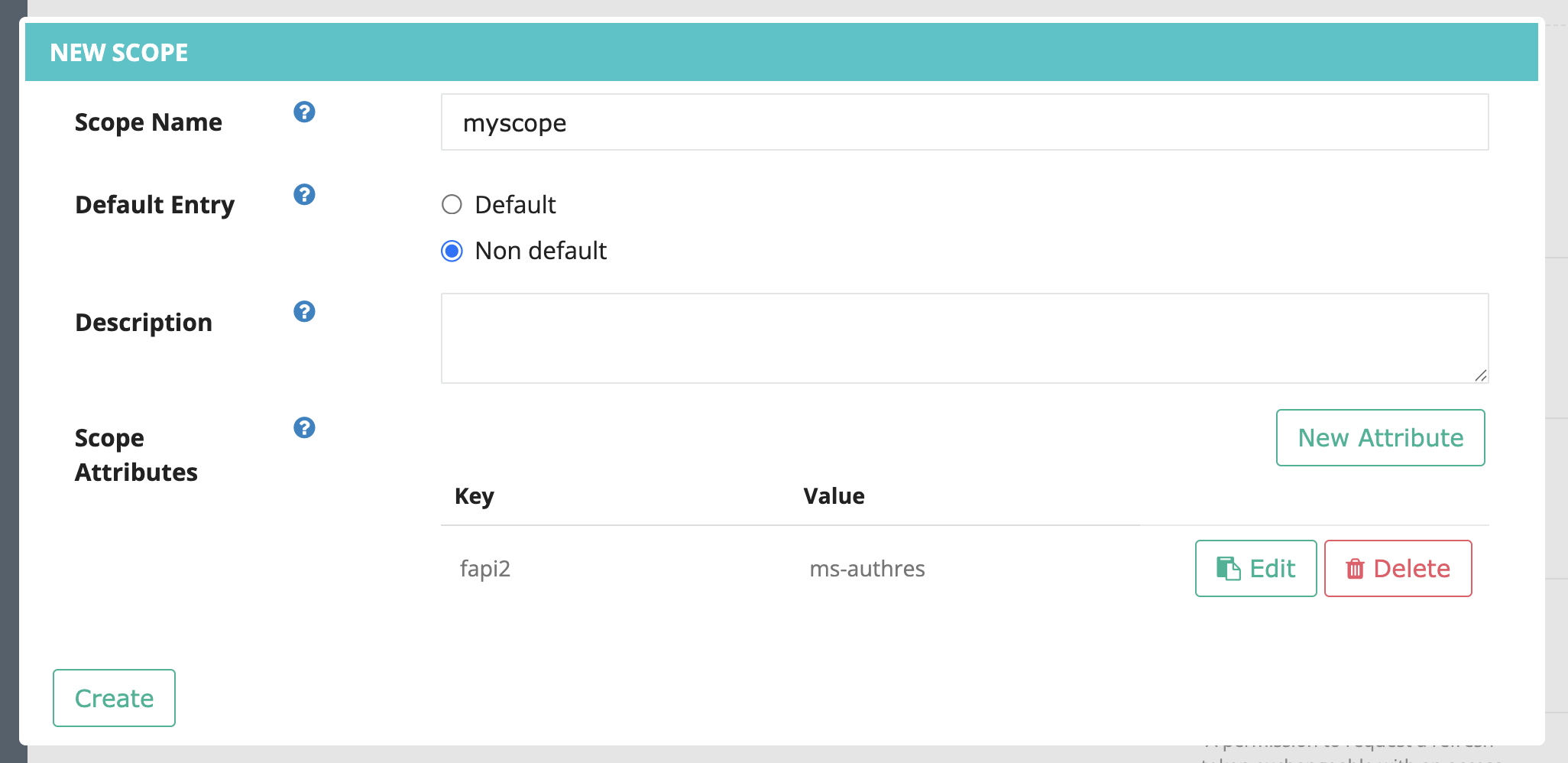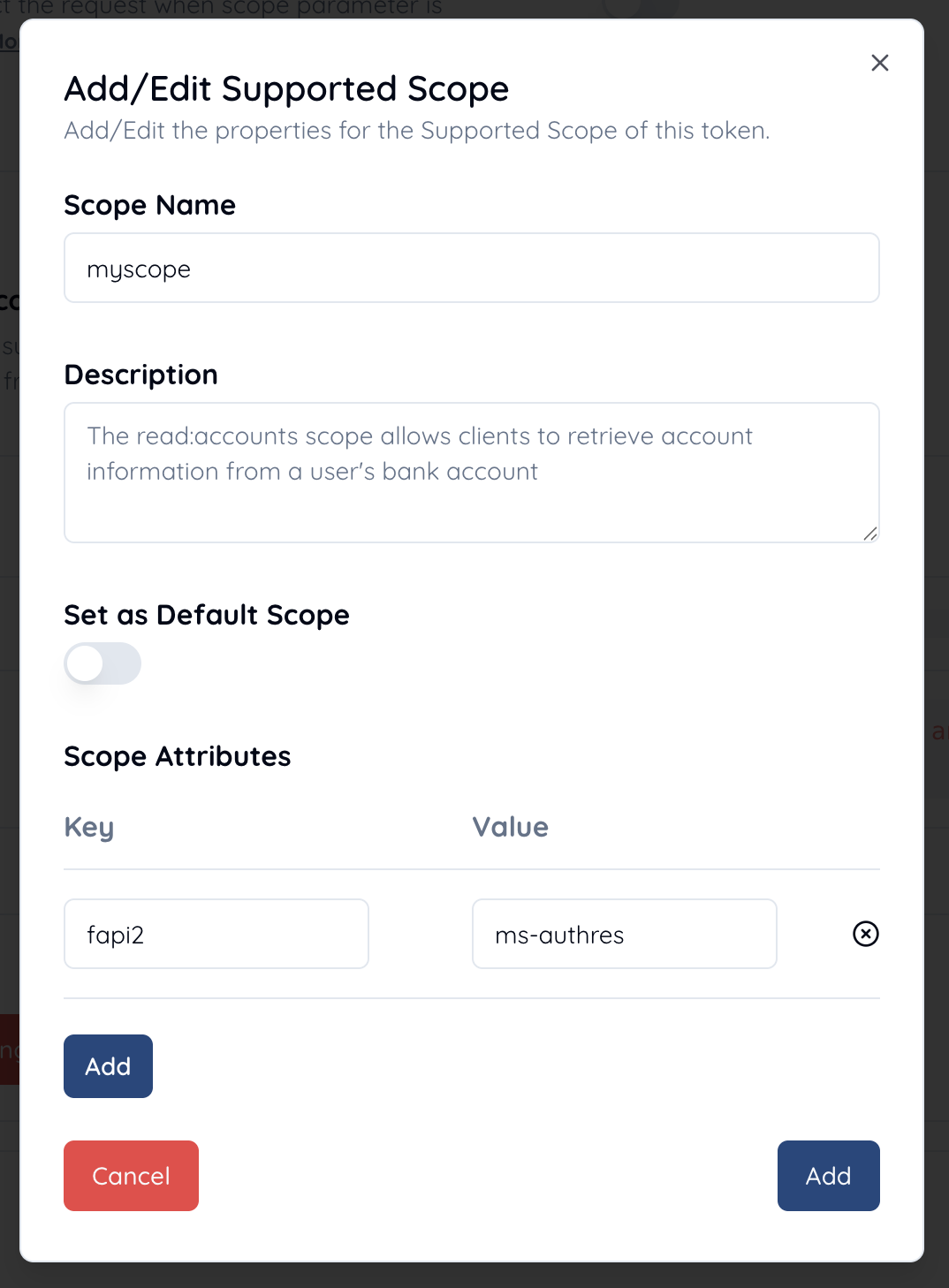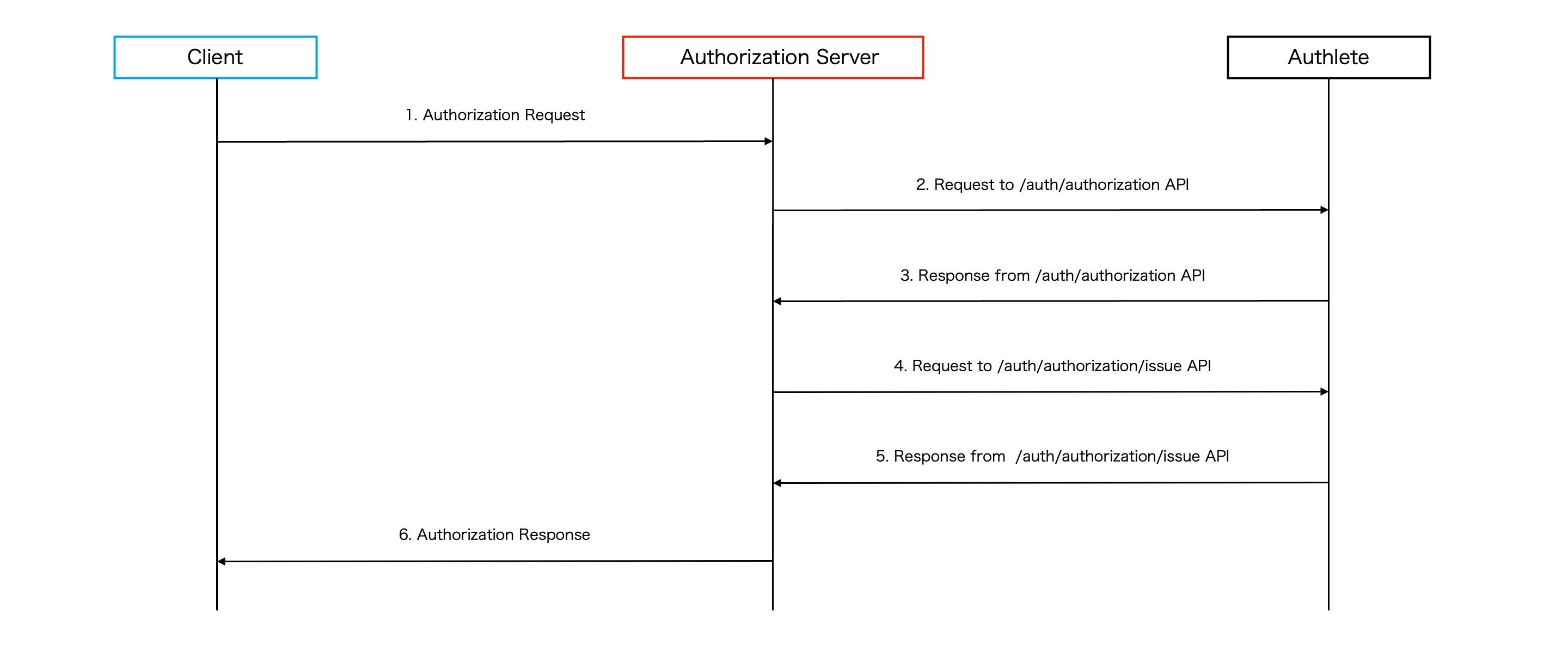Table of Contents
This article explains how to support FAPI 2.0 Message Signing Profile: Signing Authorization Responses (hereinafter referred to as FAPI2 authorization response signing) and in Authlete.
private_key_jwt is used for client authentication.
Configure your service as follows.

Set the authorization server’s issuer identifier.

Include FAPI.

Include AUTHORIZATION_CODE.

Include CODE.

Set the authorization endpoint URL.

Select Included.
“FAPI 2.0 Security Profile, 5.3.2. Requirements for authorization servers, 5.3.2.2. Authorization endpoint flows”
7. shall return an
issparameter in the authorization response according to [RFC9207];

Select Variable.
“FAPI 2.0 Security Profile, 5.3.2. Requirements for authorization servers, 5.3.2.2. Authorization endpoint flows”
8. shall not transmit authorization responses over unencrypted network connections, and, to this end, shall not allow redirect URIs that use the "http" scheme except for native clients that use loopback interface Redirection as described in Section 7.3 of [RFC8252];

Set the token endpoint URL.

Include PRIVATE_KEY_JWT.
“FAPI 2.0 Security Profile, 5.3.2. Requirements for authorization servers, 5.3.2.1. General requirements”
6. shall authenticate clients using one of the following methods:
- MTLS as specified in Section 2 of [RFC8705], or
-
private_key_jwtas specified in Section 9 of [OIDC];

Select Restrict.
“FAPI 2.0 Security Profile, 5.3.2. Requirements for authorization servers, 5.3.2.1. General requirements”
8. shall only accept its issuer identifier value (as defined in [RFC8414]) as a string in the aud claim received in client authentication assertions;

Set the PAR endpoint URL.

Set the duration (the expiration time for request URIs) to less than 600 seconds.
“FAPI 2.0 Security Profile, 5.3.2. Requirements for authorization servers, 5.3.2.2. Authorization endpoint flows”
12. shall issue pushed authorization requests request_uri with expires_in values of less than 600 seconds;

Select Kept.
“FAPI 2.0 Security Profile, 5.3.2. Requirements for authorization servers, 5.3.2.1. General requirements”
9. shall not use refresh token rotation except in extraordinary circumstances (see Note 1 below);
…
NOTE 1: The use of refresh token rotation does not provide security benefits when used with confidential clients and sender-constrained access tokens. This specification prohibits the use of refresh token rotation for security reasons as it causes user experience degradation and operational issues whenever the client fails to store or receive the new refresh token and has no option to retry.
However, as refresh token rotation may be required from time to time for infrastructure migration or similar extraordinary circumstances, this specification allows it, provided that authorization servers offer clients the time-limited option to retry with the old refresh token in case of failure. Implementers need to consider a secure mechanism for clients to recover from a loss of a new refresh token on issue. The details of this mechanism are outside the scope of this specification.


Create a scope named myscope and add a scope attribute with the key fapi2 and the value ms-authres.

Set an allowable clock skew value that meets the following condition:
10 seconds ≤ clock skew ≤ 60 seconds
“FAPI 2.0 Security Profile, 5.3.2. Requirements for authorization servers, 5.3.2.1. General requirements”
13. to accommodate clock offsets, shall accept JWTs with an iat or nbf timestamp between 0 and 10 seconds in the future but shall reject JWTs with an iat or nbf timestamp greater than 60 seconds in the future. See Note 3 for further details and rationale;
…
NOTE 3: Clock skew is a cause of many interoperability issues. Even a few hundred milliseconds of clock skew can cause JWTs to be rejected for being “issued in the future”. The DPoP specification [RFC9449] suggests that JWTs are accepted in the reasonably near future (on the order of seconds or minutes). This document goes further by requiring authorization servers to accept JWTs that have timestamps up to 10 seconds in the future. 10 seconds was chosen as a value that does not affect security while greatly increasing interoperability. Implementers are free to accept JWTs with a timestamp of up to 60 seconds in the future. Some ecosystems have found that the value of 30 seconds is needed to fully eliminate clock skew issues. To prevent implementations switching off iat and nbf checks completely this document imposes a maximum timestamp in the future of 60 seconds.

Set the authorization server’s issuer identifier.

Enable this setting.

Include AUTHORIZATION_CODE.

Include CODE.

Set the authorization endpoint URL.

Disable this setting.
“FAPI 2.0 Security Profile, 5.3.2. Requirements for authorization servers, 5.3.2.2. Authorization endpoint flows”
7. shall return an
issparameter in the authorization response according to [RFC9207];

Enable this setting.
“FAPI 2.0 Security Profile, 5.3.2. Requirements for authorization servers, 5.3.2.2. Authorization endpoint flows”
8. shall not transmit authorization responses over unencrypted network connections, and, to this end, shall not allow redirect URIs that use the "http" scheme except for native clients that use loopback interface Redirection as described in Section 7.3 of [RFC8252];

Set the token endpoint URI.

Include PRIVATE_KEY_JWT.
“FAPI 2.0 Security Profile, 5.3.2. Requirements for authorization servers, 5.3.2.1. General requirements”
6. shall authenticate clients using one of the following methods:
- MTLS as specified in Section 2 of [RFC8705], or
-
private_key_jwtas specified in Section 9 of [OIDC];

Enable this setting.
“FAPI 2.0 Security Profile, 5.3.2. Requirements for authorization servers, 5.3.2.1. General requirements”
8. shall only accept its issuer identifier value (as defined in [RFC8414]) as a string in the aud claim received in client authentication assertions;

“FAPI 2.0 Security Profile, 5.3.2. Requirements for authorization servers, 5.3.2.2. Authorization endpoint flows”
12. shall issue pushed authorization requests request_uri with expires_in values of less than 600 seconds;

Disable Refresh Token Rotation.
“FAPI 2.0 Security Profile, 5.3.2. Requirements for authorization servers, 5.3.2.1. General requirements”
9. shall not use refresh token rotation except in extraordinary circumstances (see Note 1 below);
…
NOTE 1: The use of refresh token rotation does not provide security benefits when used with confidential clients and sender-constrained access tokens. This specification prohibits the use of refresh token rotation for security reasons as it causes user experience degradation and operational issues whenever the client fails to store or receive the new refresh token and has no option to retry.
However, as refresh token rotation may be required from time to time for infrastructure migration or similar extraordinary circumstances, this specification allows it, provided that authorization servers offer clients the time-limited option to retry with the old refresh token in case of failure. Implementers need to consider a secure mechanism for clients to recover from a loss of a new refresh token on issue. The details of this mechanism are outside the scope of this specification.

Set an allowable clock skew value that meets the following condition:
10 seconds ≤ clock skew ≤ 60 seconds
“FAPI 2.0 Security Profile, 5.3.2. Requirements for authorization servers, 5.3.2.1. General requirements”
13. to accommodate clock offsets, shall accept JWTs with an iat or nbf timestamp between 0 and 10 seconds in the future but shall reject JWTs with an iat or nbf timestamp greater than 60 seconds in the future. See Note 3 for further details and rationale;
…
NOTE 3: Clock skew is a cause of many interoperability issues. Even a few hundred milliseconds of clock skew can cause JWTs to be rejected for being “issued in the future”. The DPoP specification [RFC9449] suggests that JWTs are accepted in the reasonably near future (on the order of seconds or minutes). This document goes further by requiring authorization servers to accept JWTs that have timestamps up to 10 seconds in the future. 10 seconds was chosen as a value that does not affect security while greatly increasing interoperability. Implementers are free to accept JWTs with a timestamp of up to 60 seconds in the future. Some ecosystems have found that the value of 30 seconds is needed to fully eliminate clock skew issues. To prevent implementations switching off iat and nbf checks completely this document imposes a maximum timestamp in the future of 60 seconds.


Create a scope named myscope and add a scope attribute with the key fapi2 and the value ms-authres.
Configure your client as follows.

Select CONFIDENTIAL.

Include AUTHORIZATION_CODE.

Include CODE.

Register at least one redirect URI starting with https.

Select PRIVATE_KEY_JWT.
“FAPI 2.0 Security Profile, 5.3.3. Requirements for clients, 5.3.3.1. General requirements”
2. shall support client authentication using one or both of the following methods:
- MTLS as specified in Section 2 of [RFC8705],
-
private_key_jwtas specified in Section 9 of [OIDC];

Select ES256.
“FAPI 2.0 Security Profile, 5.4. Cryptography and secrets, 5.4.1. General requirements”
1. Authorization servers, clients, and resource servers when creating or processing JWTs shall
adhere to [RFC8725];
use
PS256,ES256, orEdDSA(using theEd25519variant) algorithms; andnot use or accept the none algorithm.

Set a JWK set. Since we use private_key_jwt for client authentication, the JWK set must include a signing key for client assertions. Note that keys contained in the JWK set must satisfy the following requirements.
“FAPI 2.0 Security Profile, 5.4. Cryptography and secrets, 5.4.1. General requirements”
2. RSA keys shall have a minimum length of 2048 bits.
3. Elliptic curve keys shall have a minimum length of 224 bits.

Select CONFIDENTIAL.

Include AUTHORIZATION_CODE.

Include CODE.

Register at least one redirect URI starting with https.

Select PRIVATE_KEY_JWT.
“FAPI 2.0 Security Profile, 5.3.3. Requirements for clients, 5.3.3.1. General requirements”
2. shall support client authentication using one or both of the following methods:
- MTLS as specified in Section 2 of [RFC8705],
-
private_key_jwtas specified in Section 9 of [OIDC];

Select ES256.
“FAPI 2.0 Security Profile, 5.4. Cryptography and secrets, 5.4.1. General requirements”
1. Authorization servers, clients, and resource servers when creating or processing JWTs shall
adhere to [RFC8725];
use
PS256,ES256, orEdDSA(using theEd25519variant) algorithms; andnot use or accept the none algorithm.

Set a JWK set. Since we use private_key_jwt for client authentication, the JWK set must include a client assertion signing key. Note that keys contained in the JWK set must satisfy the following requirements.
“FAPI 2.0 Security Profile, 5.4. Cryptography and secrets, 5.4.1. General requirements”
2. RSA keys shall have a minimum length of 2048 bits.
3. Elliptic curve keys shall have a minimum length of 224 bits.
This section demonstrates Authorization Code Flow in FAPI2 authorization response signing by using Authlete APIs.

Suppose that a client that implements FAPI2 authorization response signing sends a valid request to the pushed authorization request endpoint of the authorization server. The client and the request should meet the following requirements.
The client uses private_key_jwt for client authentication at the pushed authentication request endpoint (as configured above).
The scope request parameter includes myscope, which is linked to an attribute fapi2=ms-authres as configured above.
The response_type request parameter is set to code.
“FAPI 2.0 Security Profile, 5.3.3. Requirements for clients, 5.3.3.2. Authorization code flow”
1. shall use the authorization code grant described in [RFC6749];
The code_challenge request parameter must be set to an appropriate value and the code_challenge_method request parameter must be set to S256.
“FAPI 2.0 Security Profile, 5.3.3. Requirements for clients, 5.3.3.2. Authorization code flow”
3. shall use PKCE [RFC7636] with
S256as the code challenge method
The redirect_uri request parameter must be set and it must be a URI starting with https. In this demonstration, we use the redirect URI registered in the client settings.
“FAPI2 Security Profile, 5.3.2. Requirements for authorization servers, 5.3.2.2. Authorization endpoint flows”
6. shall require the
redirect_uriparameter in pushed authorization requests8. shall not transmit authorization responses over unencrypted network connections, and, to this end, shall not allow redirect URIs that use the "http" scheme except for native clients that use loopback interface Redirection as described in Section 7.3 of [RFC8252];
The response_mode parameter must be set to jwt.
“FAPI 2.0 Message Signing Profile, 5.4. Signing authorization responses, 5.4.1. Requirements for Authorization Servers”
Authorization servers implementing FAPI2 authorization response signing
1. shall support, require use of, and issue signed authorization responses via JWT Secured Authorization Response Mode for OAuth 2.0 [JARM].
“FAPI 2.0 Message Signing Profile, 5.4. Signing authorization responses, 5.4.2. Requirements for Clients”
Clients implementing FAPI2 authorization response signing
1. shall set the response_mode to jwt in the authorization request as defined in [JARM];
Taking all of the requirements above into account, the request that the client send to the pushed authorization endpoint would be like below.
POST /par HTTP/1.1
Host: server.example.com
Content-Type: application/x-www-form-urlencoded
client_assertion_type=urn%3Aietf%3Aparams%3Aoauth%3Aclient-assertion-type%3Ajwt-bearer
&client_assertion=eyJraWQi...
&client_id={Client ID}
&response_type=code
&redirect_uri=https%3A%2F%2Fclient.example.org%2Fcb
&scope=myscope
&code_challenge=E9Melhoa...
&code_challenge_method=S256
&response_mode=jwt
After the authorization server receives the request from the client, the authorization server calls Authlete /pushed_auth_req API including the received parameters.
Below is a curl command that simulates a request from the authorization server to Authlete /pushed_auth_req API.
curl -s -X POST https://api.authlete.com/api/pushed_auth_req \
-u '{Service API Key}:{Service API Secret}' \
-H 'Content-type: application/json' \
-d '{"parameters":"client_assertion_type=urn%3Aietf%3Aparams%3Aoauth%3Aclient-assertion-type%3Ajwt-bearer&client_assertion=eyJraWQi...&client_id={Client ID}&response_type=code&redirect_uri=https%3A%2F%2Fclient.example.com%2Fcb&scope=myscope&code_challenge=E9Melhoa...&code_challenge_method=S256&response_mode=jwt"}'curl -s -X POST https://us.authlete.com/api/{Service ID}/api/pushed_auth_req \
-H 'Authorization: Bearer {Authlete API Access Token}' \
-H 'Content-type: application/json' \
-d '{"parameters":"client_assertion_type=urn%3Aietf%3Aparams%3Aoauth%3Aclient-assertion-type%3Ajwt-bearer&client_assertion=eyJraWQi...&client_id={Client ID}&response_type=code&redirect_uri=https%3A%2F%2Fclient.example.com%2Fcb&scope=myscope&code_challenge=E9Melhoa...&code_challenge_method=S256&response_mode=jwt"}'A successful response from the API contains a request URI. The response would look like below.
{
"resultCode": "A245001",
"resultMessage": "[A245001] Successfully registered a request object for client ({Client ID}), URI is urn:ietf:params:oauth:request_uri:6uOtgZjBYPPspJLf630c8iJfi4xql_G3R7MKMjgTxRk.",
"action": "CREATED",
"requestUri": "urn:ietf:params:oauth:request_uri:6uO...",
"responseContent": "{\"expires_in\":300,\"request_uri\":\"urn:ietf:params:oauth:request_uri:6uO...\"}"
}

After obtaining a request URI in step 1, the client sends an authorization request, including the request URI, to the authorization endpoint of the authorization server. The request appears as below.
GET /oauth/authorize?client_id={Client ID}&request_uri=urn:ietf:params:oauth:request_uri:6uO... HTTP/1.1
Host: server.example.com
When the authorization server receives the request from the client, the authorization sever calls Authlete /auth/authorization API.
Below is a curl command that simulates a request from the authorization server to Authlete /auth/authorization API.
curl -s -X POST https://api.authlete.com/api/auth/authorization \
-u '{Service API Key}:{Service API Secret}' \
-H 'Content-type: application/json' \
-d '{"parameters":"client_id={Client ID}&request_uri=urn:ietf:params:oauth:request_uri:6uO..."}'curl -s -X POST https://us.authlete.com/api/{Service ID}/auth/authorization \
-H 'Authorization: Bearer {Authlete API Access Token}' \
-H 'Content-type: application/json' \
-d '{"parameters":"client_id={Client ID}&request_uri=urn:ietf:params:oauth:request_uri:6uO..."}'A successful response from the API would be like below.
{
"type": "authorizationResponse",
"resultCode": "A004001",
"resultMessage": "[A004001] Authlete has successfully issued a ticket to the service (API Key = {Service API Key}) for the authorization request from the client (ID = {Client ID}). [response_type=code, openid=false]",
"ticket": "CBKnPeMO...",
...
}
After the authorization server receives a successful response from /auth/authorization API, the end-user authorizes/denies the client’s request in the browser. The authorization result is then conveyed to the authorization server and the authorization server calls Authlete /auth/authorization/issue API with the result.
Below is a curl command that simulates a request from the authorization server to Authlete /auth/authorization/issue API.
curl -s -X POST https://api.authlete.com/api/auth/authorization/issue \
-u '{Service API Key}:{Service API Secret}' \
-H 'Content-type: application/json' \
-d '{"ticket":"CBKnPeMO...","subject":"john","result":"AUTHORIZED"}'curl -s -X POST https://us.authlete.com/api/{Service ID}/auth/authorization/issue \
-H 'Authorization: Bearer {Authlete API Access Token}' \
-H 'Content-type: application/json' \
-d '{"ticket":"CBKnPeMO...","subject":"john","result":"AUTHORIZED"}'A successful response from the API will include an authorization code, as shown below.
{
"type": "authorizationIssueResponse",
"resultCode": "A040001",
"resultMessage": "[A040001] The authorization request was processed successfully.",
"authorizationCode": "smseP17u...",
"responseContent": "https://client.example.org/cb?response=eyJraWQi...",
...
}
You can find the response parameter in responseContent, and it contains a JWT (eyJraWQi...).
The payload of the JWT contains an authorization code as follows.
{
"aud": "{Client ID}",
"code": "smseP17u...",
"iss": "https://server.example.com",
"exp": 1702725889
}

After obtaining an authorization code in step 3, the client sends a request, including the authorization code, to the token endpoint. Similar to the requirement at the pushed authorization request endpoint, the token endpoint authenticates the client using private_key_jwt.
Also, we assume that the authorization server issues access tokens that are sender-constrained with DPoP based on the following requirements:
“FAPI 2.0 Security Profile, 5.3.2. Requirements for authorization servers, 5.3.2.1. General requirements”
4. shall only issue sender-constrained access tokens,
5. shall use one of the following methods for sender-constrained access tokens:
- MTLS as described in [RFC8705],
- DPoP as described in [RFC9449];
“FAPI 2.0 Security Profile, 5.3.3. Requirements for clients, 5.3.3.1. General requirements”
1. shall support sender-constrained access tokens using one or both of the following methods:
- MTLS as described in [RFC8705],
- DPoP as described in [RFC9449];
Therefore, the client must present a DPoP proof JWT for the authorization server to obtain a sender-constrained access token.
Note that DPoP proof JWTs must be signed with PS256, ES256 or EdDSA.
“FAPI 2.0 Security Profile, 5.4. Cryptography and secrets, 5.4.1. General requirements”
1. Authorization servers, clients, and resource servers when creating or processing JWTs shall
adhere to [RFC8725];
use
PS256,ES256, orEdDSA(using theEd25519variant) algorithms; andnot use or accept the none algorithm.
Taking the requirements above into account, a request to the token endpoint would look like as below.
POST /oauth/token HTTP/1.1
Host: server.example.com
Content-Type: application/x-www-form-urlencoded
DPoP: eyJ0eXAi...
client_assertion_type=urn%3Aietf%3Aparams%3Aoauth%3Aclient-assertion-type%3Ajwt-bearer
&client_assertion=eyJhbGci...
&client_id={Client ID}
&code=smseP17u...
&redirect_uri=https%3A%2F%2Fclient.example.org%2Fcb
&grant_type=authorization_code
&code_verifier=ErRt0wrt...
After the token endpoint receives a request from the client, the authorization server calls Authlete /auth/token API.
Below is a curl command that simulates a request from the authorization server to Authlete /auth/token API.
curl -s -X POST https://api.authlete.com/auth/token \
-u '{Service API Key}:{Service API Secret}' \
-H 'Content-type: application/json' \
-d '{"parameters":"client_assertion_type=urn:ietf:params:oauth:client-assertion-type:jwt-bearer&client_assertion=eyJraWQi...&client_id={Client ID}&code=smseP17u...&redirect_uri=https%3A%2F%2Fclient.example.org%2Fcb&grant_type=authorization_code&code_verifier=ErRt0wrt...","dpop":"eyJ0eXAi..."}'curl -s -X POST https://us.authlete.com/api/{Service ID}/auth/token \
-H 'Authorization: Bearer {Authlete API Access Token}' \
-H 'Content-type: application/json' \
-d '{"parameters":"client_assertion_type=urn:ietf:params:oauth:client-assertion-type:jwt-bearer&client_assertion=eyJraWQi...&client_id={Client ID}&code=smseP17u...&redirect_uri=https%3A%2F%2Fclient.example.org%2Fcb&grant_type=authorization_code&code_verifier=ErRt0wrt...","dpop":"eyJ0eXAi..."}'A successful response from the API will include an access token, as shown below.
{
"resultCode": "A050001",
"resultMessage": "[A050001] The token request (grant_type=authorization_code) was processed successfully.",
"accessToken": "7i9xPkbk...",
...
}

After completing all the steps above, the client gets an access token and can access a protected resource endpoint of the resource server with the obtained access token as follows.
GET /api/sample HTTP/1.1
Authorization: DPoP 7i9xPkbk...
DPoP: eyJ0eXAi...
Host: resource.example.com
Note that the client needs to present a DPoP proof JWT to the resource server’s endpoint along with the access token.
When the resource server receives the request from the client, the resource server calls Authlete /auth/introspection API to verify the access token.
Below is a curl command that simulates a request from the resource server to Authlete /auth/introspection API.
curl -s -X POST https://api.authlete.com/api/auth/introspection \
-u '{Service API Key}:{Service API Secret}' \
-H 'Content-type: application/json' \
-d '{"token":"7i9xPkbk...","dpop":"eyJ0eXAi...","htm":"GET","htu":"https://resource.example.com/api/sample"}'curl -s -X POST https://us.authlete.com/api/{Service ID}/auth/introspection \
-H 'Authorization: Bearer {Authlete API Access Token}' \
-H 'Content-type: application/json' \
-d '{"token":"7i9xPkbk...","dpop":"eyJ0eXAi...","htm":"GET","htu":"https://resource.example.com/api/sample"}'A successful response from the API would be like below.
{
"resultCode": "A056001",
"resultMessage": "[A056001] The access token is valid.",
"action": "OK",
...
}